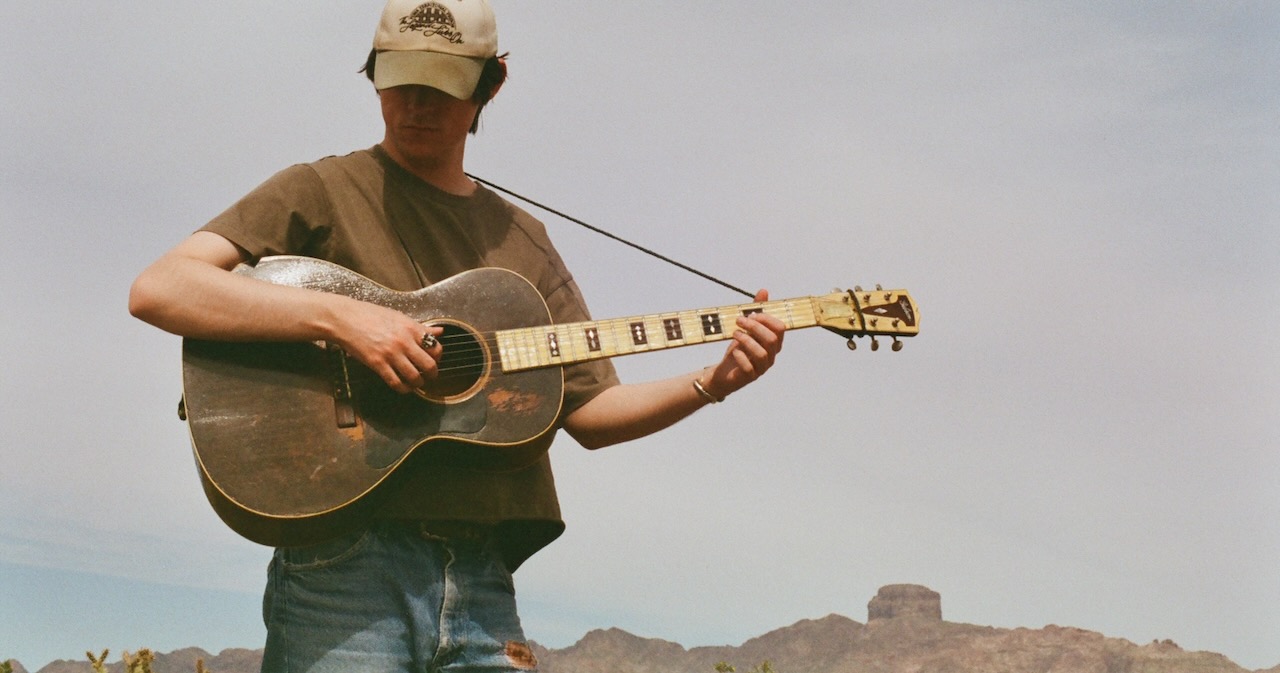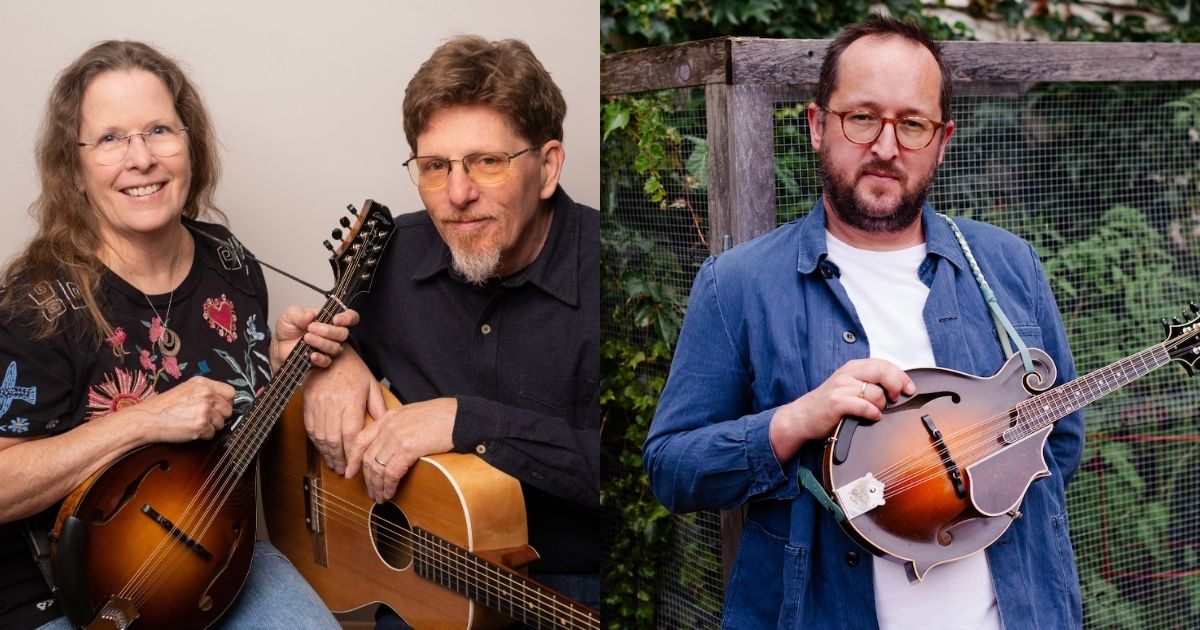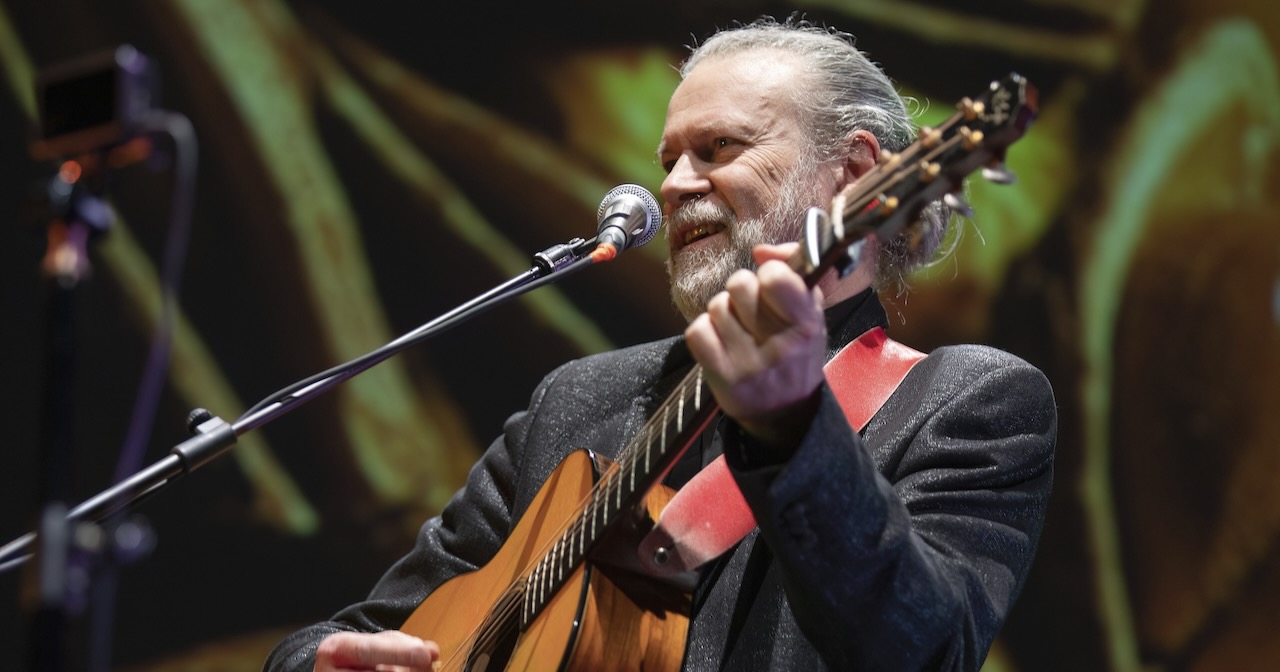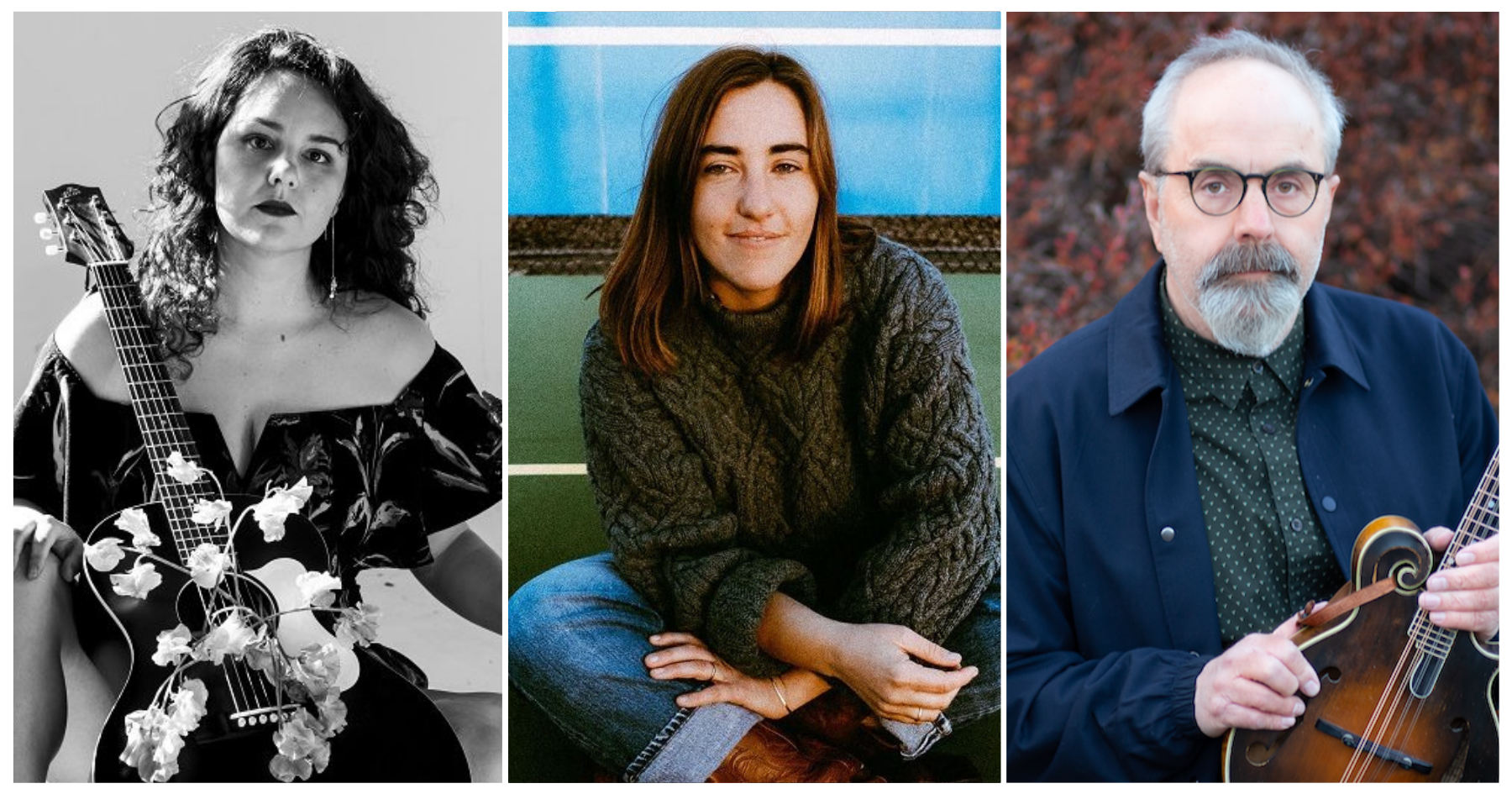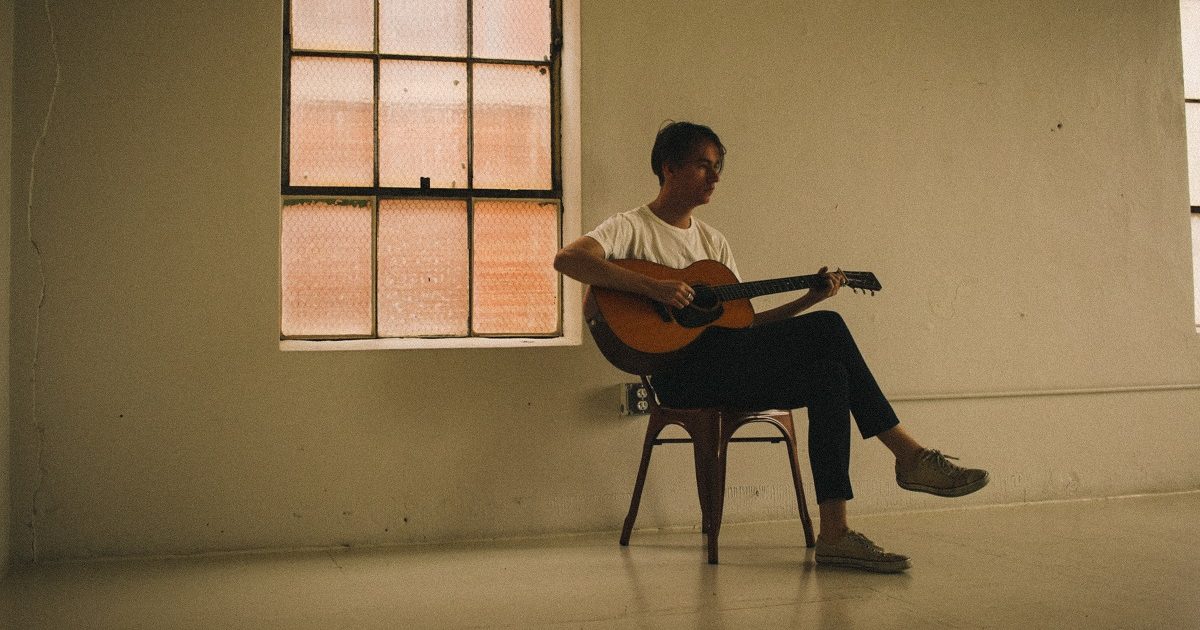It’s a warm, summery day in early April when I sit down with archivist, writer, and guitarist Cameron Knowler on the shores of Old Hickory Lake in Middle Tennessee. Both Knowler and myself happen to now live in Old Hickory, a small village in Davidson County that was formerly a DuPont company town and is nestled on the edges of the eponymous, manmade US Army Corps of Engineers lake on the Cumberland River.
The setting is a far cry – geographically, topographically, and ecologically – from Knowler’s hometown of Yuma, Arizona, a place that serves as the inspiration, background, and foreground of his stunning new solo guitar album, CRK (released April 4 by Worried Songs). Knowler’s upbringing in Yuma was traumatic and bleak, not exactly a storybook experience by any measure. Still, like many roots musicians and creatives, the landscapes and dioramas of the wild west California/Arizona border town have become the guitarist-composer’s primary muse.
CRK sounds like the desert. Like hot, searing parking lots. Like mesquite and cactuses and roadrunners and mesas and red rocks. Stark flatpicked and finger-plucked melodies give equal consideration and immortalization to sweeping natural landscapes and small, depressingly human settings, too. Unlike so many of his subjects and inspirations in and around Yuma, this collection of compositions never moves to pave over the intricacies, nuances, and subversions Knowler finds in revisiting his hometown in music and memories. Still, the album is as gorgeous and transportive as any of our favorite famous paintings of the Old West, or soundtracks to iconic western films, or depictions of ancient pueblos. Perhaps his subject is a strip mall or a vignette of the proverbial “suburban hell,” but in this context each feels like an entire universe unto itself, a dreamscape – a home.
CRK opens with a gorgeous prose poem set to music, a track titled “Christmas in Yuma.” Immediately, the record is thereby attached through terroir and tradition to other western artists like Steinbeck and McCarthy. The album’s package is ornamented with gorgeous photographs, polaroids, bits of imagery, printed art, and poetry, further evoking artists we associate with the Southwest like Dorothea Lange and Linda Hogan. But the stories herein are told almost exclusively by guitar – usually Knowler solo as centerpiece, but sometimes joined by ensembles including guitarists Jordan Tice (who co-produced the project) and Rich Hinman, as well as other instrumentalists like Rayna Gellert, Robert Bowlin, Jay Bellerose, and more. The guitar is an instrument so pervasive and ubiquitous we often forget how aptly it can showcase these kinds of narratives, and how at home the six-string always feels in the West.
But with CRK, listeners won’t ever forget those facts. This is a narrative album. Is it also a technical achievement, intricate and intriguing and complex? Absolutely. But making an impressive guitar album was clearly not Knowler’s goal. Telling stories, with his medium being the guitar and the traditions that encircle it, was his chief aim. To say the project is successful in this regard would be an embarrassingly trite understatement.
And so, while watching the springtime water birds and snacking on lunch – with Knowler’s neck, wrists, and fingers dripping in Native-smithed silver and turquoise – we two sat down on the banks of a long, twisting lake on the Cumberland River in Nashville to discuss the guitar, the desert, and the little town on the banks of the Colorado River called Yuma – that Cameron Knowler once, and still, calls home.
I wanted to start by talking about place. I’m obsessed with how music has been slowly but surely divorced from its relationship to place over time. Your album, what jumped out at me immediately was it has such a strong relationship to place. How do you take something physical, tangible, geographical – a place like Yuma or Old Hickory Lake – and translate that into your medium? How do you think about evoking landscape or evoking an image with music?
Cameron Knowler: That’s a great question. I have like 10 ways of responding to that. As you said, music is getting divorced from place and I think it’s something of a cliche at this point that we’re losing regionalism. In the sense that, even with bow strokes– fiddlers in Galax, Virginia are different than fiddlers in northern Virginia. Not consciously, necessarily, but just as a colloquialism. As a part of their place. I didn’t [have] an old man or an old woman playing a fiddle who taught me tunes, I never had any of that [regionalism]. Instead, the “white kid from the suburbs” phenomenon happened. When I moved to Texas, I got connected with a regional fiddler in Terlingua, Texas – kind of [where the movie], Paris, Texas started. I learned his repertoire, which was interesting in that he learned a lot from Brad Leftwich when they were young and living in Santa Barbara. That was the void that I was missing. Not even musically, just in my life. I lost my mom, I lost my dad, I didn’t have family, so to me that was a cue, like a clue.
Then it flips, because there is a robust fiddle tradition of the Tohono O’odham [Nation] right there on the Yuma, Arizona/California border. But that’s not my culture. I could have gone in and said, “I’m gonna learn this tune” – or melody or whatever. Then that [could be] my way into the landscape. Instead of coming at it from an internal perspective, it was an external perspective, basically like a western painter. Like an oil painter painting Tucson or Walpi.
To answer your question, it’s slippery, ’cause you can’t go on stage and say, “Okay, this instrumental song is about a grocery store that I grew up driving by.” [Laughs] I can’t say that. It does come from that place, but I don’t say that. For me, the visual aspects of the record, I weigh them as equally, I would say, as the sonics. I think that’s where I can insert song titles – all the song titles on the record are related to Yuma.
There’s this tradition of stark solo or nearly solo acoustic guitar as an iconic sound of “the Wild West.” One of the first things I thought about listening to CRK is the score and soundtrack for Brokeback Mountain, so much of it is just solo plucked, tender guitar. Then of course in other music that evokes the West, you have sweeping strings and countrypolitan country and western. Even in that context you’ll often hear nylon-string guitar out front, solo. There’s something about unadorned guitar that is connected to landscapes.
But what I’m hearing you say is it’s not about translating the grandeur of Western landscapes at all. It’s about the grocery store, or it’s about the building that burned down, or it’s about a stretch of miles and miles of highway.
Totally. Yes. There’s so much programmed into the sound. David Rawling says, “The sound of a minor chord is a cowboy dying,” which is such a great way of saying that.
I believe this is true of the development of the flat-top guitar in general. At a certain point in 1934 or 1933, when the dreadnoughts start to get developed, there’s something about that that conveniently carries forward the agenda of interrelated musics – like Hawaiian music and bluegrass music for two totally different agendas. Then that [sound and body style] becomes the golden standard. But there were so many other brands and makers and thinkers from different cultures making guitars that, in an alternate universe not far from our own at all, would’ve been the golden standard. I feel the same way about the tradition of the music itself, right? And a dreadnought itself can do an infinite number of things, but just the format itself excludes a lot. As a constant instrument to play solo.
Another thing that David Rawlings says about his small guitar is that the smallest things sound the biggest, when they are in their own diorama – describing what he does with Gillian [Welch]. That’s his goal, to convince listeners that the “baby dinosaur” [small guitar] can actually eat them. Working in miniature, making little boats in glass bottles, you open yourself up, it’s an entire universe. The littlest things sound the biggest. In that way, there’s opportunity in the format itself.
I think people like Norman Blake and John Steinbeck are both hyper-regionalists who synthesize very eclectic sources to create something that is uniquely their own, but also totally comes outta left field. ‘Cause yeah, you think about Norman and certain people would say he is a flatpicker. Some people would say he was a pot smoking hippie who played with John Hartford – and they’re both equally true! Tying together otherwise disparate histories is a compelling format and is rewarding to the solo practitioner, I think.
We should talk about Steinbeck. We talked about it a couple of weeks ago when we first met by chance. But you starting the album with “Christmas in Yuma,” immediately I was like, “Oh, I know where we are. I know what we’re doing.” We’re in the West, there’s poetry/prose poetry happening. That song feels like it’s part of a longstanding tradition. Immediately I was thinking about a couple of my favorite Steinbeck passages listening to that.
Starting with poetry, starting with spoken word over that beautiful sound bed that you’ve created for it, what does that accomplish for you as an opening to a record?
Two things come to mind. Kenneth Patchen, who made these poetry records for the Folkways label in the ‘50s backed by a jazz band and it was almost comical, but he took it so seriously and it’s so convincing when you just forget what the format actually is. The great Texas – I don’t even wanna say outsider artist, but in terms of how he’s viewed – outsider artist Terry Allen, with some of his concept records like Lubbock (On Everything) with the pedal steel. You can do anything at that point. That’s why I started [CRK] out that way.
Also, quite frankly, Ice Cube’s records – I’m thinking of N.W.A. – start out with these sound collages of him getting arrested or walking down a cell block, or the imagined character is. To me, he could do anything after that point. He could make the amazing record that it became, or he could have done some something entirely different. I just think it’s an earnest way of saying, “I’m not trying to do what you [already] know.” We all know that everyone is infinitely complex, but in terms of what they release, it’s fine to not be infinitely complex?
For me, it’s not a flatpicking record. It’s not a fingerpicking record. I’m really not trying to make it a guitar record, so to speak. I wanted to make it a narrative record. [“Christmas in Yuma”] was just an earnest way of saying, “I’m not what you think I might be.”
It’s also a tradition in these roots and folk music spaces to play with expectation. People generally know what a solo guitar record is gonna sound like and what it’s gonna be and what it’s gonna do. I’m imagining a program director at a radio station putting on the record and doing the 30-second listen through – and the first song is poetry?!
I think maybe that’s what you’re talking about? Whatever conscious or subconscious projection you might have about what this album is in your hand, or what this is about to be as you put it on, you want to play with that projection. You’re saying, “I’m gonna tell you what this is.”
That is a beautiful point because, not to go too far back [in my history], but I was “unschooled” and I didn’t have a high school diploma or a GED. [Through all the hardships I’ve faced], I’ve learned this notion of leveraging. I surveyed how I was going to be able to reach people, and it gets more representative of myself as [time] goes. But it’s always been under the guise of leveraging unexpected muscle groups towards something else. That’s just built into this like fight or flight thing. I just have nothing to lose.
Your point about the radio DJ – or whoever that’s listening to the poetry – I think that’s a unique opportunity. At that point, they’re suspending judgment. If I wanna listen to a guitar record, I’m gonna listen to Leo Kottke 6- and 12-String Guitar. It’s perfect. It does exactly what it needs to do.
People should continue to try to make records like that. To me, it’s not a push against that at all. It’s starting out on a different foot. You may end up in a place that, by design, is very different than you would if you just tried to hit it on the nose. You can still hit it on the nose. Then you might even have a chance to open it up to somebody. Sometimes people just don’t know who Norman Blake is. But then, there’s a tune like “Yuma Ferry.” Who plays like that? Norman plays like that. If I were to make a whole record of “Yuma Ferry”-style tunes, I think everybody listening would know that it was a Norman Blake type of thing.
Let’s talk about “Christmas in Yuma” a little more in detail, because I’m curious about how you created it. Was it the poem that made the music happen, or the music demanded to have a poem set to it? What was the creative process like for the track?
I woke up from a nap on December 21, 2021, and I just went to Google Docs and typed it out. It just came out like that. The recording process, I had my friends Harry and Dylan sit down with me in our friend Marshall’s studio and we just recorded improvisations with the loose framework. [It’s read by my friend] Jack Kilmer, who similarly grew up in the Southwest. His father, like my mother, was also Christian Scientist. Those are all the things that were vibrating around. I was like, “He has to do it.” He’s an amazing voice actor, amazing actor, and just a great musician. Very musical and a beautiful artist. I had him do it first.
Then we went to the studio and we just said, “This is how long the track is. We’re not gonna play to the track. We’re just gonna play.” There was one take that was like the perfect length of time and I just put it under there. All those sonic features that interact with the vocal are totally incidental.
The music of CRK is so evocative and so visual and is so good at text painting, but I wanted to talk about your work in other media and about how you curated the package for the album, too. You’re so multifaceted in what media you’re working in – archives, photography, visual art, written word, music, melody. How do you see all those forms converging and diverging with this project specifically? Because I see your eye for detail at every level. You can just tell from the package that the whole thing is art to you, not just the songs.
Photography, it is always fiction. That, to me, is the beauty of it. If there’s a picture of someone jumping, you don’t really know where they jumped from. Or if they smile, they are actually crying? Maybe this person crying is not the good guy. Maybe they’re the bad guy.
You can start to track things like that, as the smile gets “invented” throughout photography. But it’s this line of fiction that, if you spend enough time with it, you can infer things right or wrong in there. They can all take you to a different place. Movies are that way, but you lose a little bit with the moving image. ‘Cause then you see the speed at which they’re moving, even if the frame rate isn’t representative of reality.
But then, say you’re playing jazz standards and you’re playing things with semantic content that came from a show, a Broadway show in the ‘40s. You’re shackled by the semantic content of that. I think it’s a convenient metaphor, in my opinion, to see photography and instrumental music as this thing, where – back to working in miniature – smaller things give you more room to insert yourself into it. I shouldn’t say more room, but there’s more fiction to play with, I would argue.
There’s less to compete with.
Right? In terms of things being programmed to you. In movies, you have the aesthetics, you have the costumes, you have the music, you have all this stuff. With photo books, the way that they’re sequenced by gestures is such a fitting way of dealing with sequencing things that aren’t visual. There’s a lot of inspiration from the photo book as a tradition, in terms of sequencing. And how with photojournalism, we don’t really have an American, coalesced identity of the West without the photography of the Dust Bowl. I’ve spent a lot of time looking at FSA photographs and there’s some great Dorothea Lange photographs in Yuma from May of 1935 which can be seen via the Library of Congress. I actually licensed one of them that was not within the purview of her [federal] work from the Oakland Museum and that’s in the song folio for CRK.
Obviously, Norman Blake is a really important musician to you and Dave Rawlings is as well. You’re talking about wanting to make music, wanting to make a record that isn’t just another acoustic guitar, flatpicking, flat-top record. Norman and Dave are great examples of guitarists who make albums that aren’t just the same old same old, and aren’t just products, they’re art. Both showcase that simple solo guitar, that miniature world we’re talking about, can be so expansive and huge and lush. But who are the others? Who are the folks that modeled for you that having your own voice and perspective on your instrument was more important than just doing it to do it. Or to be “best” or to sell yourself as a product for consumption?
For banjo, I think John Hartford. I love the idea that Blake Mills said, he called guitar an instrument for assholes. [Laughs] What I love about that is, no matter how you look at a guitar, the guitar is always a toy. [Andrés] Segovia tried to institute a formal repertoire. The bluegrass people tried to, the rock people [tried to]. Is Jimi Hendrix the definitive repertoire for the guitar? AC/DC? But, it’s still a toy. It’s still marketed as a toy.
I don’t need a million people to listen to my music to make a living or to keep doing it. It’s all within the art/archives, how to make these raw ingredients that are embedded into everyone into something that’s not commercial, but digestible.
In terms of other people [who inspired me]. John Fahey. Leo Kottke, but I didn’t fingerpick up until about three and a half years ago. About 80% of the record is finger picking. To your point about the poem earlier, there’s more outside of the solo, acoustic guitar canon of stuff, too. People like Rambling Jack Elliot and Sam Shepard, yeah.
One final point, I would play these solo concerts in Texas of just flatpicking melodies, like four flatpicking melodies in four different keys. And I was just like beating my head up against a wall, trying to tell some sort of cinematic, fiddle tune-driven [story over an entire set of just flatpicking]. I wanted there to be an arc. Through stubbornness, I decided I was going to learn how to fingerpick convincingly, where I had control of each voice. It’s really hard. It was a pain in my ass to figure that shit out.
But yeah, I see them all as tools: the poetry, the flatpicking, the fingerpicking, the drumming. It could be seen as pushing back against commercialism or whatever, but in some ways it’s actually the opposite. I was like, “I want more. I want a diverse audience. I want as many people to listen to this as possible.” Not sheer numbers, but in terms of who they are and what their listening diets are. Not just everybody in the audience being someone who will already know each of those fiddle tunes.
Photo Credit: Steve Perlin
